 Whether you are putting together long-term food storage or simply want to have garden-fresh fruits and vegetables all winter long, the key to successfully preserving food is proper packaging. After all, all the freeze-drying in the world won’t do you much good if your food is improperly stored in containers and packaging that don’t preserve the integrity of the food.
Whether you are putting together long-term food storage or simply want to have garden-fresh fruits and vegetables all winter long, the key to successfully preserving food is proper packaging. After all, all the freeze-drying in the world won’t do you much good if your food is improperly stored in containers and packaging that don’t preserve the integrity of the food.
Packaging is so important because it is the only barrier between your food and the elements that can make it spoil. To prevent spoiling you want to eliminate three main things: Light, oxygen, and water. When you freeze dry or dehydrate food, you create a hostile environment for microorganisms. Without sufficient water and oxygen, microorganisms can’t grow. And, by removing light and heat you also slow down the growth of microorganisms that will ruin all the hard work you have put in to long-term food storage.
Location Matters
There’s a reason our forefathers built cold storage in basements—they’re great at keeping out light and the temperature stays naturally cool. You can easily stash your food in the kitchen pantry if you have it packaged it in a jar. But, keep in mind that regular use and exposure to light and heat will significantly shorten the shelf life of your food. So, when possible, outfit a room with shelves and keep your food nestled safely in the type of environment it needs (like a cool basement or a dark closet) and it will last for decades.
Types of Packing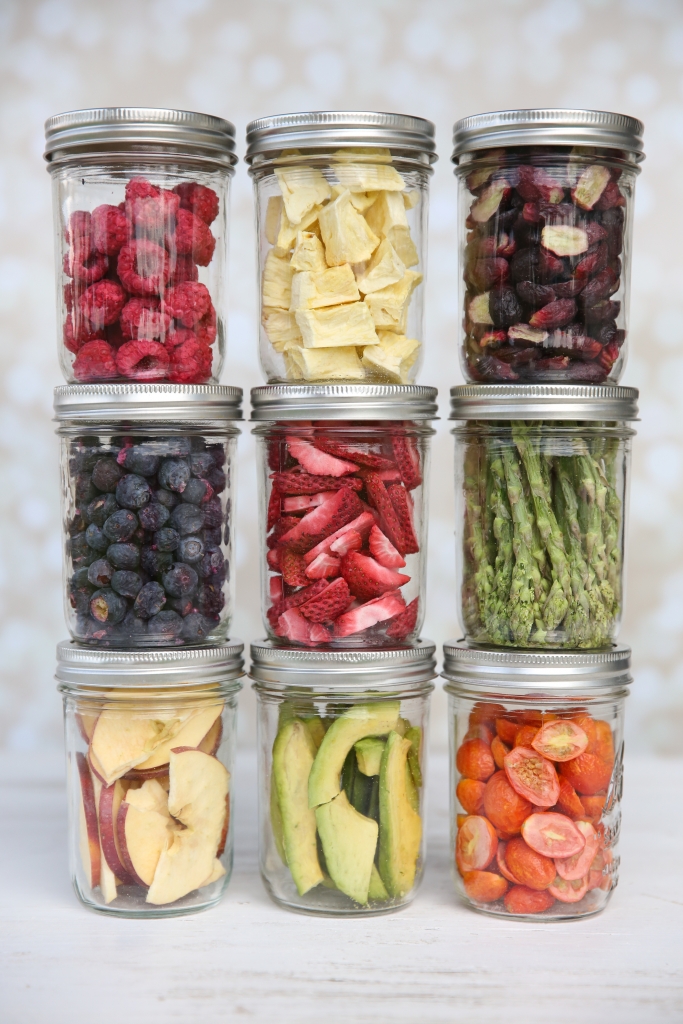
Jars – You don’t have to make jam or pickles to take advantage of the art of canning. Traditional canning jars are perfect for storing freeze-dried foods. All you need to do is make sure they are sanitized and add an oxygen absorber to lock your food up nice and tight for the long haul. (Some choose to use a vacuum sealer to seal their jars, but it’s vital that all the oxygen is removed when using this method.)
An advantage of jars is that they can be reused and you can easily see what you preserved. If you plan to use your food in the near future, using a reusable resource like jars is smart and saves money. Keep in mind that jars will allow light in, so it’s crucial that any food stored in jars is kept in a dark place.
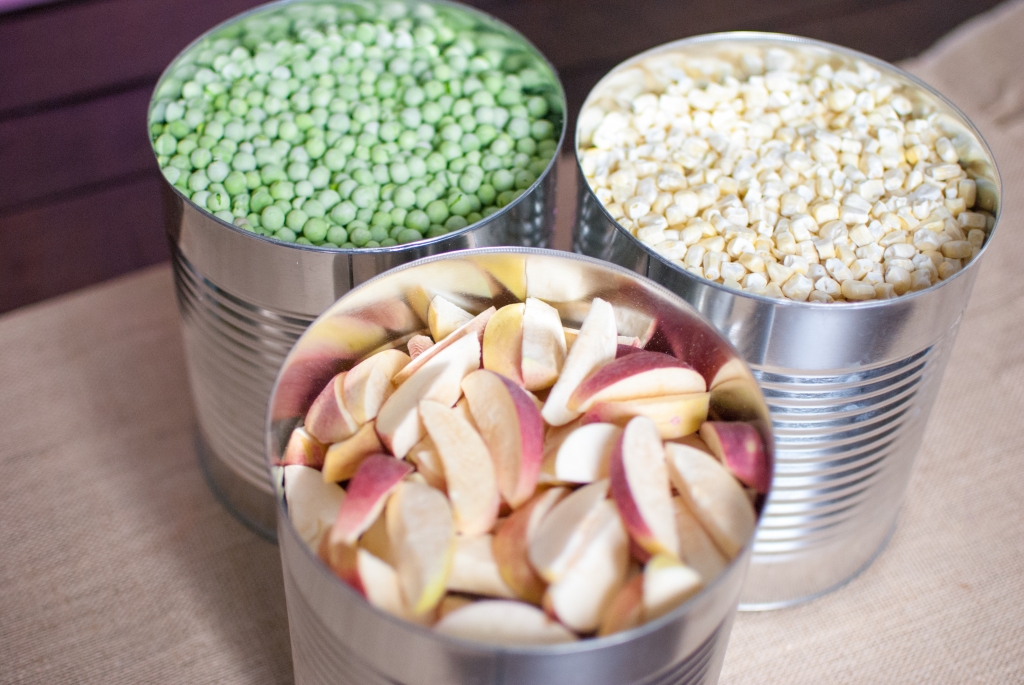 Cans – Cans are a great food storage choice. Not only are they airtight, but they also prevent incidental exposure to light. The methods are very similar to the process used to package food in jars. One downside to cans is that they can’t be reused or resealed. With that in mind, be judicious when deciding which foods to place in cans. A gallon of freeze-dried food is a lot. Once cans are opened, the food needs to be used. So, you may want to portion your food in smaller packages inside the cans to make for manageable meal sizes.
Cans – Cans are a great food storage choice. Not only are they airtight, but they also prevent incidental exposure to light. The methods are very similar to the process used to package food in jars. One downside to cans is that they can’t be reused or resealed. With that in mind, be judicious when deciding which foods to place in cans. A gallon of freeze-dried food is a lot. Once cans are opened, the food needs to be used. So, you may want to portion your food in smaller packages inside the cans to make for manageable meal sizes.
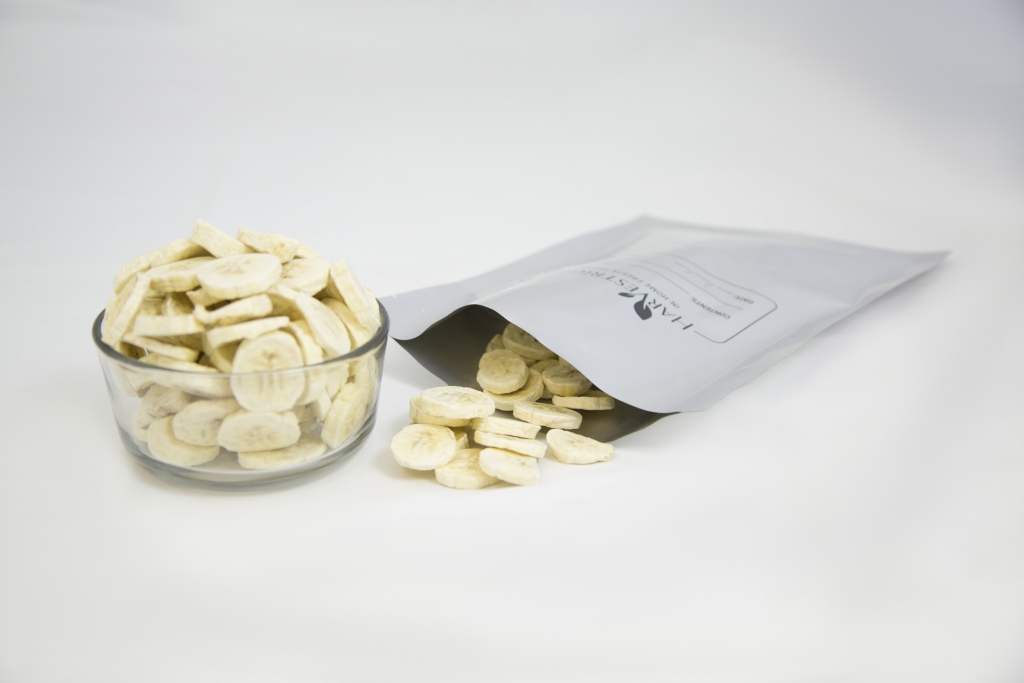 Mylar Bags – This may be the simplest way to package your preserved foods. All you need to get started are the bags and an impulse sealer. Mylar bags do a good job of blocking out light and air, but you do want to make sure to remove as much as air as possible before sealing the bags. Oxygen absorbers are the best! Depending on the foods you are preserving, bags can take up less space than jars or cans, too. Another plus is that Mylar bags can be resealed once opened and they can be washed out and reused, similar to a canning jar. Mylar bags are also easily portable during and emergency.
Mylar Bags – This may be the simplest way to package your preserved foods. All you need to get started are the bags and an impulse sealer. Mylar bags do a good job of blocking out light and air, but you do want to make sure to remove as much as air as possible before sealing the bags. Oxygen absorbers are the best! Depending on the foods you are preserving, bags can take up less space than jars or cans, too. Another plus is that Mylar bags can be resealed once opened and they can be washed out and reused, similar to a canning jar. Mylar bags are also easily portable during and emergency.
Plastic Buckets – Big, plastic buckets are often used to store food. They do a fine job of keeping out most air and light and the plastic is not vulnerable to pests and rodents. Another upside is that they are stackable. You do need to have sufficient room for them, but they can be a great way to keep foods (like grains or several mylar bags) that would take up a large number of smaller containers.
Specialized Food Storage Containers – There are containers designed specifically for long-term food storage. These systems definitely provide the protection needed, but the downside is expense. They are often pricey, and sometimes require purchase of other products or the company’s own food items. Space can be another concern, as these types of containers are usually quite large.
Extras That Help
Vacuum Packing Machine – Because oxygen is one of the enemies of food preservation and it’s absolutely everywhere, this can become your secret weapon. The vacuum packing machine helps you remove excess air from cans, jars, bags, or buckets before sealing them. It’s a good way to seal your food. The major downside is that they don’t get out all the oxygen and the packaging typically used is clear plastic. Both water and oxygen can pass through this plastic. So, for medium range storage (two to three years) they are great.
Oxygen Absorbers – These little babies are a must-have. 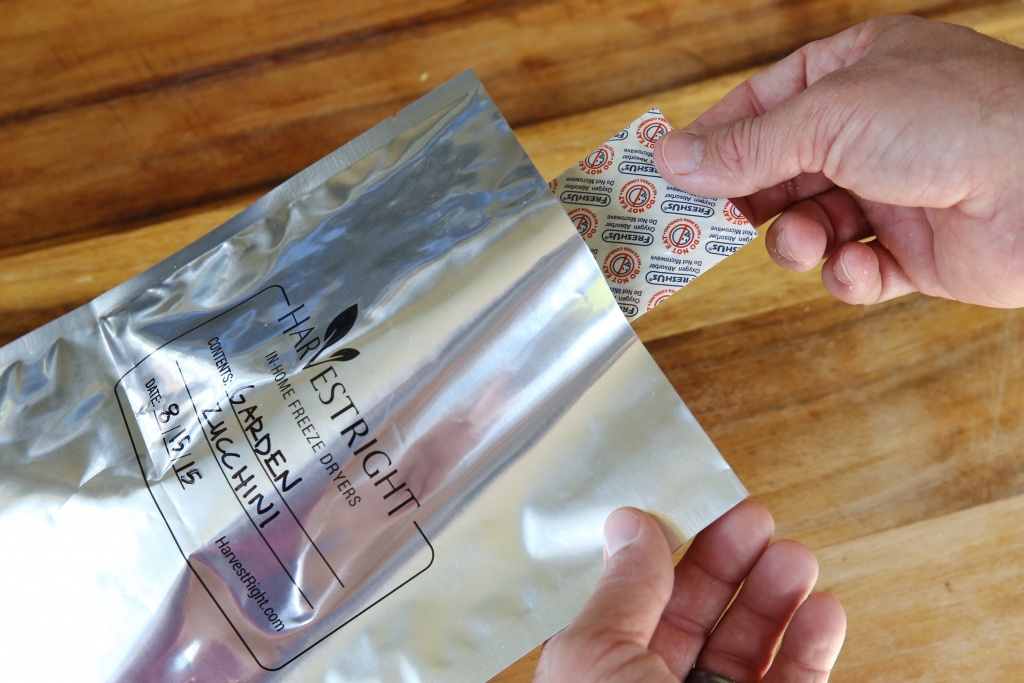 No matter what your chosen packaging method, adding a couple of these devices to your food will make a huge difference in the longevity of your preserves.
No matter what your chosen packaging method, adding a couple of these devices to your food will make a huge difference in the longevity of your preserves.
If you’re taking the time and care to preserve food, you want to make sure it lasts. Use these helpful tips to get the most out of your long-term food storage efforts.

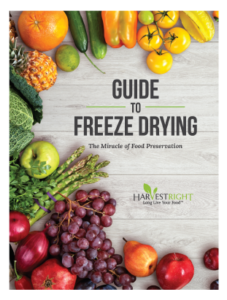
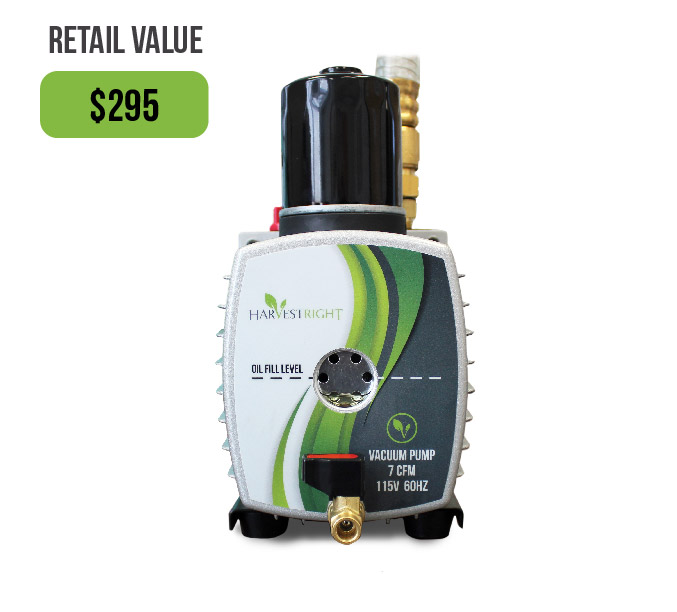
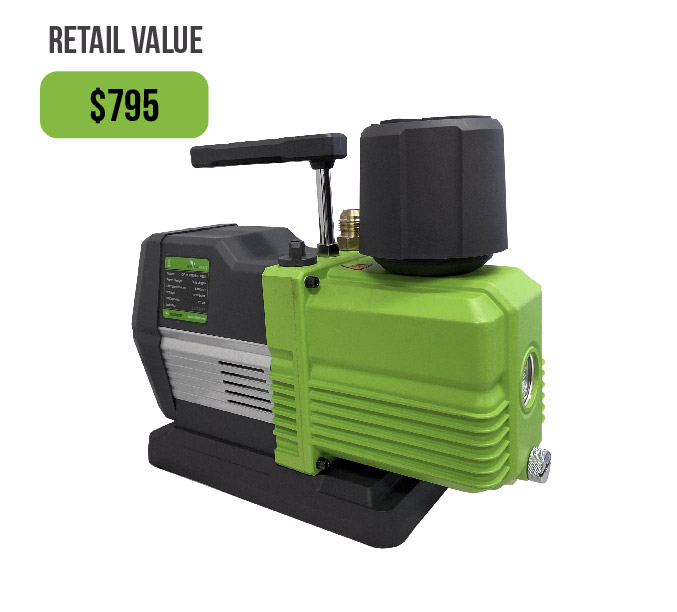
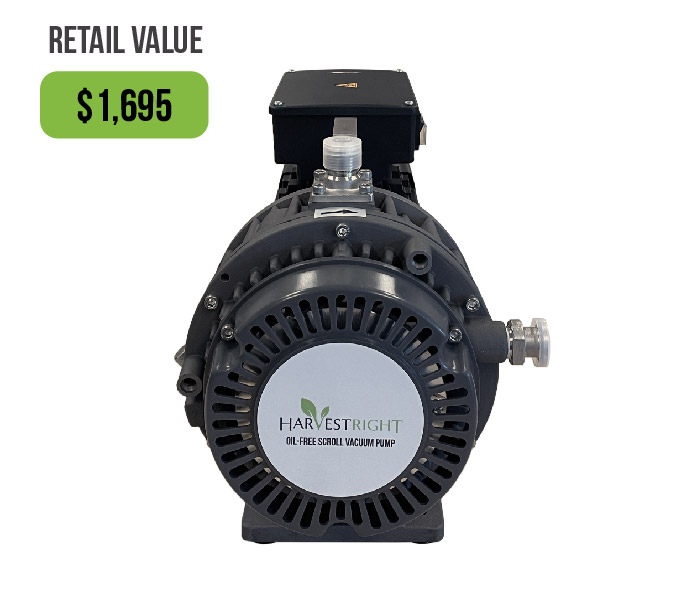
How many oxygen packs do you put in the large Mylar bags?
Thanks
One 300cc oxygen absorber works for one gallon container.
When freeze drying in a freezer’, and you have waited the required time, and they are light weight, and airy, but covered in frost from being in the freezer, what next? You can’t wrap them as is, they will reconstitute from the coldness/moisture in the ice. Do I room/air dry, or put in a warm oven, … or what? Thanks!
We aren’t sure we understand the question. Feel free to clarify if we didn’t understand.
When we freeze dry, we use an actual freeze dryer. We don’t do it in a freezer. That method doesn’t really work.
Freeze drying is a two part process that is accomplished within the vacuum chamber – freezing followed by drying. Pre-freezing in your home freezer can reduce the time required to complete the full cycle in the Harvest Right machine. Once the pre-freeze cycle is completed in your home freezer you must transfer the trays/product to the vacuum chamber and run the complete cycle as per instructions. Any frost or other added moisture will be removed through the “Drying” cycle which uses hard vacuum and heat. Once both cycles are completed the product has negligible h2o content. The oxygen getters remove the O2 but air tight packaging should take place immediately once the food passes the moisture check – it is easier to understand once you get comfortable with the reliable system of HarvestRight. See the many videos. This is a new experience you will master.
Can I remove air from the Mylar bags and seal the mylar bags by using my vacuum sealer?
Yes. But, we still recommend an oxygen absorber, especially for long-term food storage.
How do you remove air from the mylar bag? I tried on my food saver and it didn’t work
You can add an oxygen absorber. It will activate and take the air out of the package. Some people do try to “push” a bit of the air out before they seal the bag, but the oxygen absorber will do the work!
I’ve found that since the mylar bags don’t have the “channels” needed to use the “Food Saver” brand vacuum sealer, I’ve taken to cut a small (maybe 3″-4″ x 1/8″ narrow piece of the channeled portion of a Food Saver bag. I then place it in the middle of the mylar bag opening (perpendicular to the opening). Make sure the channeled piece is long enough to stick out just a bit into the vacuum trough and long enough to reach the food inside the mylar bag; you’ll probably need to push the food closer to the opening to make this work. This narrow piece of channeled Food Saver bag is enough to channel the air out of the mylar bag, or any other non-channeled bag. Since mylar is a bit thicker than a normal Food Saver bag I find I need to seal the mylar 2-3 times with the Food Saver machine to make sure it actually sealed. I then use my hand held sealer to make double sure it sealed. Hope this helps. Just my 2 1/2 cents worth.
Worth more than that!! Thanks!
this method has worked well for me!
Wife and I are utilising Foodsaver vacuum packing to seal smaller lots and then storing multiple food packages in mylar to exclude light. We include an oxygen absorber in each Foodsaver bag and then an additional one in the mylar bag. This way we get the benefit of vacuum packing and can make mini-meals – with mixed packages of foods – per mylar bag. Perhaps overkill but our only concern is – will the Foodsaver plastic bags last for many years? We recognise Foodsaver is intended for short/med term (dehydration) preserving, but with complete freeze drying the contents followed by storage inside a mylar bag to exclude light, hopefully the (Foodsaver) bags will be up to the task. Any comments?
I have been packaging mine like this also. I actually was looking to see if there was any information or tips on this method. thank you for sharing this.
If you vacuum seal your Mylar bags tightly this can create tiny micro holes inside the mylar bag and cause the food to take on moisture overtime, so I choose not to vacuum Mylar bag so tight that this could happen. I just push as much air out as possible and put a oxygen absorber in plus if you suction completely So tight that you suck out the nitrogen also and that is not a good thing also.
It is vary easy if you have the right tool. You would need a chamber vac.
Hi Scott, will a chamber vacuum definitely work with smooth Mylar bags? How is the air drawn out if the two ends are in contact with each other?
Nick – I just bought a chamber vacuum machine to use for mylar. This video shows a chamber vacuum machine being used to vacuum and seal a mylar bag: https://www.youtube.com/watch?v=7aspOQmeEf8
**not endorsing the product or company in the video in anyway, just an example of a chamber vacuum machine & how it works with a smooth mylar bag. 🙂
“Retired at 40” you tube videos shows you how to use your freeze dryer as a vacuum chamber.
He removed the shelf then put one of the trays upside down in the bottom and then clipped off the corner of the sealed bag so the air can be vacuumed out. He showed doing one bag. He folds over the bag so that it kind of shuts it but the air can still be sucked out of it. A person might be able to do multiple bags if they’re leaning against each other to keep the top half of the bag folded over. He said it may take a few tries to figure out the quirks.
Or canning jars can be used and you just put the clean lid on the jars and screw the vans down till they’re not tight just barely loose so air can come through but still hold it down.
He then uses the test button at the top left to turn the vacuum on for about two minutes.
When he turned it off The jars are sealed tight but the mylar bags only hold the vacuum suction for a bit, long enough for you to quickly seal the clipped corners of the collapsed mylar bag.
You can use a hand sealer to seal all but the last 1/4 inch of the bag. Then seal 90 down 1 inch parallel to the side of the bag. Use the accessory attachment if you have one and suck the air out. Then use the hand sealer to seal the last 1/4 inch of the bag just below the accessory nozzle. Along that 1 inch seam you made. It works well
I bought freeze dried potato….I put in mylar bags with a 300cc o2 absorber….nothing happen that appeared to remove air…..how li g will it keep i. Those bags
Hi Debra. The O2 absorber will attract oxygen and sort of lock it up so it is not accessible to interact with the dried food. The 300cc will work for a container up to 1 gallon in size due to its oxygen absorbing ability. You will not see “air” leaving the bag since it’s still technically there in the bag. Try reading up further how they work if you need more information.
How long does the food last in the mylar bag without the oxygen absorber? Some of my oxygen absorbers were exposed to air and I did not know it when they were placed in the mylar bags. I love my Harvest right and will continue to use it!
Thank you for your comment. The oxygen absorber is very important. We suggest re-packaging your food, especially if contains fat. Oxygen reacting with fat is what causes food to go rancid.
Since the oxygen absorbers quickly react and become ineffective when left exposed a sealed bag, I suggest placing uhe unused oxygen absorbers in another milar bag, seal it and each time opening it, cut last tab and reseal. Also include the “pink” tablet. It turns “blue” when packages are becoming ineffective. Don’t know any way to tell if oxygen absorbers no longer effective. I would “think” if the were in the original bag or jar, konce the bag or jar is “opened” you should use a NEW oxygen absorber to insure protection.
The oxygen absorbers get hard over time as they are used up. If the package still feels like it is very sandy inside then it should be okay but if it has become hard then it is no good.
I’ve found the easiest way to preserve the unused Oxy-Absorbers after the original package has been opened is to place them in a quart size canning jar then use my Food Saver jar attachment to suck all the air out of the jar. I also place the pink tab at the inside bottom of the jar so I can easily see that the Absorbers are still good.
I use a small Mason jar with the band and cap for the o2 absorbers if I don’t use them in on session. I open a pack of 10 o2 absorbers and put the rest in the jar and leave on counter. Then come back and do the same thing over…
Hi! Thanks for all the good information. We just bought a Harvest Right Dryer and I am mostly concerned about storing things like Dairy, eggs, and other items that don’t store well. Do you have any tips on drying more liquid things like sour cream, cottage cheese, eggs, etc.?
Thanks!
Ladd, we recommend watching some of the videos on the video page of our website. It will give some tips for freeze drying dairy, eggs, cheese, etc. We recommend for long-term storage putting these in a mylar bag with a good oxygen absorber. The shelf life should be 10 to 15 years for things like this.
LONG Term Storage comes in many fashions but for real LONG term storage, I mean the 15 to 20 year kind you need to step up the quality of Mylar bag you use. You really need to get at least the 5 mil bag, much heaver, but you will also need a better vacuum machine. I know it can cost a lot upfront but in the very long run it can pay off. I have the Harvest Right Freeze Dryer and a SAMMIC vacuum sealer. I have approximately 5,000 dollars into the setup but I know that what I seal will last well probably longer than I will need the food.
The perfect recipe is stronger bags and a stronger vacuum sealer plus an oxygen absorber and you will be successful for VERY long term storage.
Thanks! That’s why we also started to offer the 7 mil mylar bags now on our website.
So freeze dried raw meat that is properly sealed does not have to be refrigerated? This seems to crazy! Please advise! And eggs! Crazy!!
Yes. You do not need to refrigerate anything. It is shelf stable as long as it is packaged properly.
We’ve had our FD for a year now, keeping it in almost constant use. SInce we also have a big garden every year, we bought another freezer to keep the produce in until we can get it freeze dried. One stroke of luck for us–an acquaintance has chickens and more eggs than they can use. They give us all the eggs we want, we then freeze dry them, and then we give them half back. We just “scramble” them in our VitaMix. 3 dozen works nicely in the 4 trays. More than that and it takes longer than the 24 hours we like to keep it at. Also, my husband replaced the baffle in the pump with a piece of roofing tin he had. The baffle had gone rusty, and with his diy replacement and keeping the amount of food on the trays on the lower side so that it FDs in 24 hours, we have been able to go 5-10 batches before changing the oil in the pump. It’s a real learning curve, so don’t be afraid to ask those questions!
Hello! I was just wondering at what ratio do you reconstitute your FD scrambled eggs?
We just use a little bit of water and throw them in a skillet. Or, just about 1/8th to 1/4th water to the amount of eggs you are rehydrating and put them in the microwave. We cover and let the steam also do some of the work once they are heated in the microwave. Doesn’t take much.
So anything including ice cream can be stored on the shelf? Is there a certain temperature it should be stored at? Alan
Heat is one of the enemies of food, so keeping it in an air-conditioned pantry, properly packaged, should be fine. It doesn’t need to be frozen.
Once the final dry cycle has completed and the beep has sounded indicating completion, how long can the food remain in the HR unit before we have to break the vacuum and begin packaging? Our first batch has run longer than anticipated and is now scheduled to be ready at 3am.
Any reason why we can’t wait until after breakfast to open it and get started packaging?
You can allow it to finish and package the food when you can get to it. The freeze dryer puts the food in a holding state. Some choose to add dry time so that it will finish when they are available to package the food. There is no harm in adding more time.
Is there a chart available that provides details on the length of time freeze dried food can be stored? For instance, jars with oxygen absorbers vs. mylar bags with oxygen absorbers? If I don’t have a vacuum sealer, will the food not last? Would the shelf life vary depending on what food you’re storing? Sorry, new to the freeze drying process and need a little help..
I am having a hard time with sliced tomatoes …. (I am new to this also) we have run 2 loads of sliced one peeled and one not… the machine said they were ready and we packaged them in large ball jars. They shrank!! over a few days… also were sticky when they went in the jars… should we toss them? Re-freeze them? I am thinking that they are NOT totally done since they shrank…
Sounds like there was moisture maybe still in the tomatoes. You could open the jar and see if they smell okay. If so, run them through a batch of them just being dried to make sure they are dry all the way through. Or, run them through a second whole batch to remove all the water (there won’t be as much water this time) and then it can dry and make sure they are good to go. In the future, break the tomato slice in half on the larges slice and make sure it’s dry in the center of the slice. If you’re ever worried, just add more dry time at the end of a cycle.
I have a vacuum sealer for plastic, will this work for mylar. It doesn’t seem to want to create a vacuum draw.
Most vacuum sealers will not work for mylar. Using an oxygen absorber with mylar is the best option. They do a better job at removing oxygen than a vacuum sealer.
Magic Seal MS175 Vacuum Sealer Machine for Food Preservation, Nozzle Type, Compatible with Mylar Bags, Extra-Wide 8 mm Sealing Wire, Adjustable Vacuum and Sealing Time, Automatic and Manual Mode
https://www.amazon.com/gp/product/B08R2FKCF5/ref=ppx_yo_dt_b_search_asin_title?ie=UTF8&psc=1
This works great. Make sure you press the button to extend the nozzle, get the nozzle into the bag before you lock the bar down and make sure the bag goes all the way to flush with the back-stop so that the heating/sealing pad makes good contact all the way through. It will use the nozzle to vacuum the air out, then it automatically retracts the nozzle and then applies the heat to seal the now-vacuumed out bag. I’ve been using mine for a few months and it does a great job. You do still need to use O2 absorber, but this definitely removes most of the air (which contains both humidity and O2) which makes the storage that much better.
I’ve found that since the mylar bags don’t have the “channels” needed to use the “Food Saver” brand vacuum sealer, I’ve taken to cut a small (maybe 3″-4″ x 1/8″ narrow piece of the channeled portion of a Food Saver bag. I then place it in the middle of the mylar bag opening (perpendicular to the opening). Make sure the channeled piece is long enough to stick out just a bit into the vacuum trough and long enough to reach the food inside the mylar bag; you’ll probably need to push the food closer to the opening to make this work. This narrow piece of channeled Food Saver bag is enough to channel the air out of the mylar bag, or any other non-channeled bag. Since mylar is a bit thicker than a normal Food Saver bag I find I need to seal the mylar 2-3 times with the Food Saver machine to make sure it actually sealed. I then use my hand held sealer to make double sure it sealed. Hope this helps. Just my 2 1/2 cents worth.
I want to put up meats, raw and cooked. My concern is the fats and oils. How long will they keep in Mylar with O2 absorber and stored at 70 deg.? I’m wanting to get at least 20 years on all of my stores. Why do fruits only keep 2-5 years?
For your viewers – When I pack a Mylar bag – I use a vacuum cleaner with small attachment. Seal the bag with a hair straightener up to the vacuum attachment (with O2 absorber inside) switch on vacuum then seal below the attachment. This works well for all sizes of bags for a strong vacuum. Just a tip.
Same. I use a hand sealer to do all but the last 1/4 inch. then turn 90 and do 1/2 to 1 inch up down, parallel to the side. Then Use the accessory to suck the air out, and then seal the mylar along that up 1 inch down seal I just did, below the accessory nozzle. It works pretty well. But its definitely harder to make the bag move w 7mil bags compared to 5mil.
Should the food that has been freeze dried be left to reach room temperature before sealing?
Worried that condensation or similar will create problems.
It is ideal for the food to reach room temperature on the trays before packaging. Often, we will run the defrost cycle for 5-10 minutes with the food still in the freeze dryer in order to warm the trays up and prevent condensation.
How long will raw freeze dried eggs keep if placed in Mylar bags with oxygen absorbers and stored below 70 degrees?
When using canning jars for storage, do we need to use new lids, or can we reuse old lids?
I’m curious about this also. In addition, if I put something in the jar I know I will use up within a few months, or even a few years, do I have to do a vaccum seal or is that just for the many many years storage? If I have snacks on the counter that I anticipate will be eaten in a few weeks, do I need to throw in another oxygen absorber when we steal treats?
I reuse my lids because they haven’t been “water sealed” so the rubber seal is still good. I’ve found, however that sometimes the jars don’t let the lid seal like they do when they are heated in a “Water Bath”. I just grab another jar and use the same lid and it works.
Do fresh blueberries need to be cut? The freeze dries blueberries in your guide look whole.
If they are fresh blueberries, they ought to be poked or chopped.
I haven’t tried it yet but can you freeze dry popcorn seeds?
Will they still pop when heated up?
Has anyone tried it yet?
Popcorn seeds go stale after awhile and won’t all pop so I am just thinking of ways to preserve them.
It’s the moisture within the kernel that makes them pop so not sure this will work
Popcorn seeds need water in them to steam and create the pop so I wouldn’t,t think popcorn would pop after freeze drying. Although I suppose you could freeze dry them and let them set out in humid area to get some moisture back in them. Might make for a good experiment.
When you freeze dry nuts, you can extend the life, but, because of the oil content, it’s not a long-term storage option. We have freeze dried many varieties of nuts and it freshens them up perfectly, but, they will go rancid if left too long
Can you store freeze dried eggs and bacon together?
If I am using your Mylar bags and your oxygen absorbers sold on your website, can the food expectancy shelf life be 25 years, or is that only possible with the #10 can?
How long do you think items will keep in a jar with an oxygen absorber? Even though a vacuum sealed package has the most longevity, we want to stay away from plastics and like the reusable nature of glass jars….
Thank you!
If sealed properly and kept out of light they should perform similarly to high quality mylar bags.
Do you new to use new lids when using canning jars? Are they supposed to seal or is the oxygen packet in the jar sufficient?
I also use a moisture absorber, along with an oxygen absorber in my Mylar bags. Probably not necessary, but definitely can’t hurt. I also like the zip lock Mylar bags. I heat seal them near the top for that “extra” peace of mind, knowing the bags is completely sealed. And if reused later, can be double sealed again. With meat packing plants closing down, cutting production, etc. due to Covid-19, this is an ideal time to start planning ahead. Not only are shortages inevitable, prices of beef, pork, and chicken are going to sky rocket. Doing it correctly the first time is vital. Take the time to read up, follow directions, and ask questions. Forums, like this, are a superb source of information. I have learned alot on YouTube as well. Ive had my Harvest Right home freeze drier about 7 months now, and it’s nearly paid for itself already. Being prepared for emergencies, AND RETIREMENT, are the reasons I’ve invested in my machine. Prices on meats are reasonable right now, but WILL go up. Its inevitable. Start now. Harvest Right has fantastic customer service and their products are top of the line. The ONLY thing I wish for is, I’d like to see the sides of the trays just a little bit higher to hold more liquid.
Moisture absorber (dessicant) and Oxygen Absorber shouldn’t be used together. O2 Absorber uses moisture to activate and dessicant would negate that.
Ultimately, you’ll end up with a bag with no moisture but still has oxygen in it.
Do you need to do something to seal the canning jars? How long will jars last?
We try and keep our freeze dryer running all the time. Sometimes we remove the finished trays but don’t have time to put the food into mylar bags right away. I assume some moisture from the air will affect the freeze dried food. Is there an amount of time it is safe to keep the freeze dried food unsealed? We live in Utah so the air is a bit dryer that other places.
You will want to package it as quickly as possible. The moisture in the air will begin to rehydrate the freeze-dried food. Plus, you’ll want to do it quickly anyway – before your family has a chance to gobble it all up before you bag it. 😉
We are considering purchasing a freeze dryer & are wondering if an “out-of-air” vacuum sealed bags, stored in a 5 gal bucket with an oxygen absorber in the bucket, if stored in a cool place would provide a comparagle length storage as the mylar bags. We like the idea of being able to see the food, which mylar prevents.
Because plastic is semi-permeable, using plastic bags is not a viable means of keeping your long-term storage items safe. Use a sharpie on the outside of your mylar bags to write the contents and date packaged.
If the food is packaged straight from the freeze dryer will it sweat inside the bag? I usually put it in a plastic bag until it gets room temp and that bag does sweat on out side of bag but it’s still got air in it. When the pan is pulled from the dryer the pan starts defrosting and I’m
Afraid I will cause moisture.
What is the shelf life of seeds and freeze dried fruits and veggies, after opening a sealed myler bag with an oxygen absorber? I assume that the oxygen absorber won’t work after opening the bag…
It is typically recommended to use these products within about 6 months after opening.
what is the shelf life of freeze dried sour cream? It is stored in a 7mm mylar bag with an oxygen absorber in a cool dark room. we bought a 3 pound tub from costco. I also have the same question about cream cheese same amount under the same conditions.
After freeze drying my food and I put it in the mylar bags with oxygen absorber should the bag smash down in time from the oxygen going out or will it look the same as when I sealed it?
Hey there, I am a newbee. Loving my FD. So I am having trouble deciding whether my food is completely dry. Sometimes it is very cold and difficult to determine am I tasting moisture or dried coldness? I am focusing now on cooked meats (ham, beef, meatballs etc) I have noticed that some of my bags don’t feel hard and packed while some feel airtight and close to food inside. Can someone offer any advice?
I am having a really hard time getting my oxygen absorbers to actually work in my mylar bags! I watched a bunch of youtube videos and they all showed the bags sort of shrinking and they said thats how they know they got a good seal. I am looking for any tips to actually get mine to work! Its the bags, sealer, and o2 absorber packs that I purchased all from Harvest Right so they should all work together, but for some reason it isn’t. I also opened up some bags I did a couple of years ago and they were definitely not safely sealed when I did them. The food definitely should have lasted longer than it did if it had been done correctly.
Any tips or ideas? Or anyone else have the same problem and found a better way (short of buying a #10 can sealer because thats the point I am about at because I just had to throw away around 20 gallon bags of freeze dried food that was only 2 years old)
The bag does not have to shrink for the oxygen absorber to do its job. Oxygen is about 19% of the air in the bag. So, the oxygen absorber only removes that portion. It leaves the other gasses. Typically foods that are more dense (cheese or peas are a good example) that are packed full in the bag will get more of the appearance of the bag shrinking. Also, you might push out excess air when creating the flat part to seal. We have found that this helps as well.
What size oxygen assorbers for pint and quart jar for long term.
After my food has completed the freeze drying process, I need to remove the shelving unit in the freeze dryer so I can seal the food. However, before I can remove the shelving unit, I have to let the ice along the inside of the unit melt. What is the process to keep the food dry while the ice melts? Do I select defrost and leave the food on the trays in the freeze dryer? What is the best process. Thank you, Karen
the food should be on the trays, you shouldn’t have to remove the shelving unit (except for periodic cleaning). If you select defrost while your food is in the FDer then it will rehydrate and be no good. Remove the trays one at a time and get the food sealed THEN once its empty you can run the defrost to get rid of the frost.
I’m new to storing. I started with food saver and put up dry beans, rice and pasta; then I heard of Mylar bags. I’ve slipped my vacuumed food saver goods into Mylar bags and added O2 absorbers. Is this okay? Also, now I’ve started freezing dry goods then letting them sit for a couple days prior to storing. Is this good?
Do you recommend using a dessicant packet and an oxygen absorber packet or just the oxygen absorber?
Just an oxygen absorber.
Can I open a large can of dehydrated meats, separate in small portions, and then reseal in Mylar bags or jars?
I have seen several people ask this question but haven’t heard a reasonable answer so I’ll try again 😉 After items are freeze dried and you take them out to get ready to package, is there a trick to keep the condensation (from the cold trays) from starting to rehydrate the food before you can get it packaged? If you use the “warm trays” selection before removing them from the freeze dryer does that help? Or do you just need to remove the freeze dried food from the trays and let it sit for a minute to come to room temperature before packaging? (Or something else??😊) Thnx
If you press the defrost button (with the trays still in the freeze dryer) then it will warm the trays up so that they aren’t cold. We like to pull them out after about 5 minutes.
I still have not seen a response to the question, how soon after you pull the trays do you start packaging, they are still covered in frost so let them warm first or …?
It is best to use the “warm trays” function on the freeze dryer before removing the trays and packaging the food.
I have my ‘extra dry time’ set for 10 hours so I can choose when i can conveniently package the food. If you do that then once the process is complete it will go into the extra dry time cycle which continues the drying process, keeping the trays warm, and making sure the food is plenty dry so when you ‘cancel’ the extra dry time when you are ready to package the food it is warm and will not create condensation and its easier to tell if its fully dried.
Can you put chicken . carrots ,pototoes after the been freeze dried in the same mylar bag for later for soup.
Yes, that is a great idea and won’t be a problem at all.
When vacuum sealing food in jars after the jar is sealed do you leave the ring on the jar or remove the ring for storage?
If I open a sealed mylar bag after a few years, will the food degradation process accelerate or does the food degradation process proceed as it normally would from the day it was sealed
Can please tell me, if the PLA material works for storing freeze dried fruit (in a sealed zip bag)?
I’ve seen this question more than once and seeing 2 different answers. Do I need to package up my food as soon as I get out of freeze dryer or do I need to let set to get to room temperature before packaging?
Is it safe to store our freeze dried candy without oxygen absorption packets for a short time frame?
Wondering how long freeze dried pet food would last in mylar? I know that fat content affects shelf life, but I’m finding answers on the internet from “it will last 25 years!” to “the fat content will make it so it only lasts up to 5.” Anyone have the definitive on this? Thank you!
We are new to FDing so have a question:
1) Above we see fresh blueberries need to be poked. Do pre-frozen berries, (CostCo), need to be poked or does the pre-freeze break down the skins sufficiently?
2) When sealing my jars in the HRFD can I wait until I have enough (say, 8 or so) filled and with oxygen absorbers before putting them all in and pressure sealing them? It might take a couple of batches to get a load.
I FD my frozen Costco berries without poking them and it DID NOT work well, took them out poked them all and replaced in FD and started the process over, worked on two of the four trays. Going to try fresh next time.
Can I store freeze dried food long term (5 years) in glass jars after putting an oxygen absorber followed by vacuum sealing using canning lids ? I will be keeping them away from light of course
Do all freeze dried foods get a oxygen absorber? Are there any foods I should not put them in?
How do you adequately puncture, ie, 6-8 gallons of blueberries frozen or not? Thanks-
How long will freeze-dried food last without an oxygen absorber?
Hi,
With certain fruits and vegetables I have experienced that the Mylar bag shrinks like expected then loosens up after a few days. Inspecting the contents I find the food as become soft (no longer crispy) around the 02 absorber. It appears that the food has moisture. This happens most with apples, cucumbers, peppers, cucumbers and squashes. I think it’s because of the humidity in the air at the time of packaging but I am not sure. I always pack in a small air conditioned room set to the lowest temperature. Has anyone else experienced this? Thank you for any insight.
Hi!
Brand Newbie here. I see lots of questions about storing in Mason/Ball jars without answers.
We’d love to store our FD food in jars.
What is the best process for long term storage using jars? (We do not have a vacuum sealer, just a hand jar sealer.)
Is an oxygen absorber inside a tightly screwed on lid enough for long term – 5+ years?
Thank you!!
Some fruits and vegetables we freeze dry because they make great snacks. We do not plan on storing them for the long term but want to prevent them from becoming chewy because of moisture absorption – we live in a humid climate.
Can I use a moisture absorber to keep the food fresh (as it comes out of the freeze dryer) longer and save the oxygen absorbers for food to be stored for a longer time?
Do I need to put an oxygen absorber in with freeze dried candy?
It is best to use an oxygen absorber no matter the product if the goal is a long term shelf life.
I’m using an AVID chamber vacuum sealer for my mylar bags. Should I still use an oxygen absorber for long term storage.
Yes, that is the safest way to do it.
I have heard that tomato powder with get hard if you put an 02 absorber in the package. True or false ??
Could you use the freeze dryer to vacuum seal mason jars? Leave the ring loose so air can escape the jar, put the whole jar in the dryer, pump it down to as hard a vacuum as it will draw, and the lid will fall into place to hold the vacuum when you repressurize the chamber..
Nice and Very informative blog. Thank you for sharing.
Hi – Can you package freeze dried food in a paper soup bowl with a paper Heat Sealed Lid (with the oxygen absorber)? Similar to ramen bowls…
I am kinda confused. I understand that your freeze dried food should get no sunlight, yet I am so confused about lighting from my pantry. We have a great inside room with temp control and shelving, yet it has regular overhead lighting. Will this affect the food in the jars
I have a large can of freeze dried cheese in my pantry. Can I vacuum seal it in smaller jars and maintain the shelf life?
Can I vacuum seal freeze dried cheese from a large container I bought several years ago into jars? Will the shelf life diminish if I do?